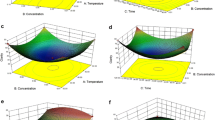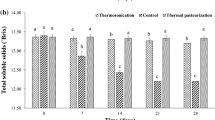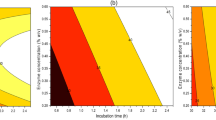Abstract
An innovative liquefaction process for the production of colouring foodstuff from purple pitaya was developed and optimized. Conducting an enzyme screening, the most suitable enzyme preparation for the liquefaction of pitaya pulp at low temperatures (4–12 °C) was selected allowing extensive viscosity reduction (50%) and high betalain retention (80%). A modified D-optimal design was used for the optimization of significant influence factors. Maximizing a heuristic optimization function composed of regression terms of the responses relative viscosity (R 2 = 0.97), betalain retention (R 2 = 0.88) and betanin–isobetanin retention (R 2 = 0.92), a numeric algorithm was established for process parameter optimization. The total juice yield was increased from 25–39 to 48–60% by implementation of the optimized liquefaction procedure into the pitaya juice production process. Mucilage separation steps were unnecessary and pitaya seeds could simply be separated as a by-product after juice filtration due to the extensive degradation of the mucilaginous matrix. In contrast to previously described mucilage liquefactions, the betalain profile was remarkably changed due to the applied enzymatic treatment resulting in a colour shift (Δh° = −14.7 ± 0.3) to bluish tones, and concentration of the so obtained pitaya juices from 12.3% TSS to 33% TSS and 65% TSS was successful at pilot plant scale.





Similar content being viewed by others
References
Wissgott U, Bortlik K (1996) Trends Food Sci Technol 7:298–302
McCann D, Barrett A, Cooper A, Crumpler D, Dalen L, Grimshaw K, Kitchin E, Lok K, Porteous L, Prince E, Sonuga-Barke E, Warner JO, Stevenson J (2007) Lancet 370:1560–1567
Stintzing FC, Carle R (2004) Trends Food Sci Technol 15:19–38
Santamaria P (2006) J Sci Food Agric 86:10–17
Acree TE, Lee CY, Butts RM, Barnard J (1976) J Agric Food Chem 24:430–431
Moßhammer M, Stintzing FC, Carle R (2005) Innov Food Sci Emerg Technol 6:221–231
Moßhammer M, Stintzing FC, Carle R (2006) Innov Food Sci Emerg Technol 7:275–287
Herbach KM, Maier C, Stintzing FC, Carle R (2007) Eur Food Res Technol 224:649–658
Sáenz C, Sepúlveda E, Matsuhiro B (2004) J Arid Environ 57:275–290
Stintzing FC, Carle R (2005) Mol Nutr Food Res 49:175–194
Paulsen BS, Lund PS (1979) Phytochemistry 18:569–571
Majdoub H, Roudesli S, Picton L, Le Cerl D, Muller G, Grisel M (2001) Carbohydr Polym 46:69–79
Stintzing FC, Carle R (2007) Trends Food Sci Technol 18:514–525
Esquivel P, Stintzing FC, Carle R (2007) J Appl Bot 81:7–14
Herjavec S, Jeromel A, Prusina T, Maslov L (2008) J Cent Eur Agric 9:505–510
Schweiggert U, Hofmann S, Reichel M, Schieber A, Carle R (2007) J Food Eng 84:28–38
Maier T, Göppert A, Kammerer DR, Schieber A, Carle R (2008) Eur Food Res Technol 227:267–275
Stintzing FC, Schieber A, Carle R (2003) Eur Food Res Technol 216:303–311
Esquivel P, Stintzing FC, Carle R (2007) Innov Food Sci Emerg Technol 8:451–457
Herbach KM, Rohe M, Stintzing FC, Carle R (2006) Food Res Int 39:667–677
Pasch JH, von Elbe JH (1979) J Food Sci 44:72–81
Petersen H (1992) Grundlagen der Statistik und Statistischen Versuchsplanung Band II, Ecomed Verlagsgesellschaft, Landsberg/Lech
Wang C, Eufemi M, Turano C, Giartosio A (1996) Biochemistry 35:7299–7307
Gorinstein S, Zemser M, Vargas-Albores F, Ochoa JL, Paredes-Lopez O, Scheler C, Aksu S, Salnikow J (1999) J Prot Chem 18:239–247
Gong F, Liang YZ, Fung YS, Chau FT (2004) J Chromatogr A 1029:173–183
Stintzing FC, Schieber A, Carle R (2002) Food Chem 77:101–106
Czyżowska A, Klewicka E, Libudzisz Z (2006) Eur Food Res Technol 223:110–116
Ganda-Herrero F, Escribano J, Garca-Carmona F (2007) J Agric Food Chem 55:1546–1551
Herbach KM, Stintzing FC, Carle R (2004) J Food Sci 69:491–498
Herbach KM, Stintzing FC, Carle R (2006) J Agric Food Chem 54:390–398
Acknowledgments
The authors thank Ellen Hemme and François Raoul-Duval (SCRD, Le Havre, France) for financially supporting this study. One of the authors (R.M.S.) is grateful for a travel grant by the Eiselen Foundation (Ulm, Germany). We thank Prof. Dr. Franz Schweiggert (Institute of Applied Information Processing, University of Ulm) for mathematical assistance in developing the optimization algorithm and the fruitful discussions with Dr. Ute Schweiggert and Georg M. Weisz are acknowledged.
Author information
Authors and Affiliations
Corresponding author
Rights and permissions
About this article
Cite this article
Schweiggert, R.M., Villalobos-Gutierrez, M.G., Esquivel, P. et al. Development and optimization of low temperature enzyme-assisted liquefaction for the production of colouring foodstuff from purple pitaya (Hylocereus sp. [Weber] Britton & Rose). Eur Food Res Technol 230, 269–280 (2009). https://doi.org/10.1007/s00217-009-1167-0
Received:
Revised:
Accepted:
Published:
Issue Date:
DOI: https://doi.org/10.1007/s00217-009-1167-0




